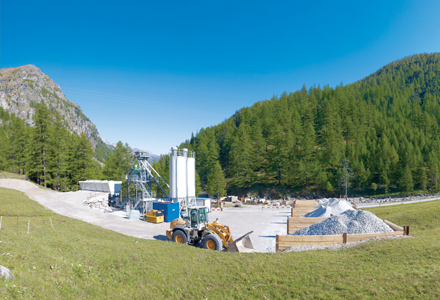
Manufcaturers are increasingly offering plants with new levels of sophistication to produce consistent, high quality concrete mixes reports Patrick Smith
Concrete plant manufacturers are responding to the trend towards ever more sophisticated recipes with equipment that offers new levels of sophistication.
Over the last few years, producers have developed equipment, such as computer controls units and other components, that can deliver a huge variety of consistent mix recipes, and store the data required to make them.
The
However, other manufacturers have also been busy developing new models to meet the worldwide demand for concrete for roads, bridges and other structures. Only recently, German manufacturer Lintec opened its new €1million factory in Jasien, Poland, and introduced new concrete and asphalt mixing plants.
An interesting development has come from Ammann with its newly-developed mixer camera that provides an insight into the otherwise concealed mixing process. The camera is installed in a ball and swivels out of the mixing chamber during filling and cleaning to protect the lens against damage and contamination. The mixing and discharging processes can be monitored on-screen.
The field of view can easily be adjusted within a wide range, said Ammann, which is also working on a semi-mobile plant with a large-volume Amix mixer to meet the demand for a high-output plant that can be relocated at low cost. The new mixing/weighing level is said to be suitable for tower plants, horizontal plants and for conversions to existing plants.
The company said its Amix twin-shaft paddle mixer is suitable for every mixing task and meets mix quality requirements even for liquid SCC (self-compacting concrete), while it has developed a consistency measurement method to document meaningful results that is "not based exclusively on the commonplace drive motor load pick-up measurement method." "The ergonomic and safe design grants easy access to plant components, thereby further reducing maintenance outlay. The mixing level has a discharge output of up to 160m³/hour and offers room for concrete mixers up to a batch size of 4m³," said Ammann.
"The arrangement of the scales for aggregate, cement and additive on the weighing level is functional and space-saving. This leaves enough room for manual or automated additive metering." Ammann produces a number of concrete plants, including the semi-mobile JustWhite. One was used during replacement of a dam wall in an equalising reservoir at Energie Electrique du Simplon in Valais, Switzerland, where Zenklusen Bau decided it would have to produce the concrete for the project on site. The construction is too far away and the roads far too tight to transport 30m³ of concrete to an elevation of 1,600m above sea level on a daily basis.
Meanwhile, Lintec's recent launches include the containerised CC 1500 B, the smallest in its concrete plant range, offering a capacity of 60m³, and the CC 3000 B.
The company's concrete and asphalt mixing plants are produced in 100%
Lintec claims its containerised mixing plants allow short erection and dismantling time; no concrete foundations are required; they are environment friendly and offer protection against rain and UV-light.
The CC 1500 B has a twin-shaft compulsory mixer with a mixer size of 1.33m³. The mineral aggregate storage unit has a volume of 90m³ with four compartments and a maximum of six binder/cement silos. Optional equipment includes 50m³ or 80m³ cement silos; a 1MW heating container and combined additive/water tank.
The CC 3000 B offers a production capacity of 120m³/hour for mobile as well as stationary use and has a 3m³ twin shaft compulsory mixer.
Mineral aggregate storage comes in an in-line 20' unit and inline 40' unit with volumes of 60m³ and 120m³ respectively. Optional equipment is the same as that offered for the CC 1500 B.
Italian company
The aggregate module can be completely transported by one vehicle, and in the transport configuration the hopper walls and loading ramp containing walls collapse into the aggregate module for easy stowing during transport.
Due to the patented movement system for the mixer, the mixing and dosing module is transported as one unit with dimensions that allow for the use of standard equipment.
The support structures of the aggregate and mixer modules are all pre-assembled, pre-wired and automated, easy and fast configuration of the modules from the transport to the working position.
The MMX's modular concept means it can be expanded by adding extra units, thus increasing the number of hoppers available and therefore the types of aggregates. The storage capacity of aggregates can be easily switched from the basic configuration of 80m³ to the configuration of 180m³.
Bulkheads below the aggregate module have a double function. They support the module, making it possible to use it without the need for civil works, and act as restraints for the loading ramp for aggregate feeding.
The MMX 5000 plant is equipped with a twin-shaft mixer that produces 3.33m³ of compacted concrete, and it is able to guarantee 130m³/hour through 40 cycles, and with a batch size of 3.33m³ the plant is optimised for the loading of 10m³ trucks.
Betomix mixing plants are supplied with ring-pan mixers holding between 1-3m³ or with twin-shaft mixers of between 2.25m³ and 6m³ capacities. It has introduced a new model, the Betomix 2.5 with a 2.5m³ twin-shaft mixer, which is a new size category that is Liebherr's response to the current truck mixer capacity trend.
"On European markets in particular, most truck mixers are of 32tonnes gross weight, with a load volume of 7.5m³. On Near East markets, volumes of 10m³ are by no means uncommon. The Betomix 2.5 therefore needs only three or four mixing cycles as the case may be to load these truck mixers," said Liebherr.
Betomix's modular element system and the availability of a large number of options for specific applications offers flexibility in operation, and another advantage of modular construction is that many components are mutually compatible, cutting delivery times and speeding up assembly work.
Among the many optional extras is the collecting hopper, which can be raised or lowered to accommodate truck heights between 3.6-4m and prevents material from contaminating the plant when truck mixers are being loaded.
Betomix mixing plant can also be specified to suit operating conditions at the intended location. In exceptionally cold regions such as Russia or Scandinavia, Betomix plant is heated and insulated so that it can operate at temperatures well below freezing point. For operation at more than 50°C the Betomix can be supplied as an option with a flake ice batching system. Adding ice to the intensive mixer lowers the temperature of the concrete.
Liebherr points out that for use by the concrete goods and precast element industries, the Betomix concept can be integrated into existing production buildings and processes.
"Configured as tandem or four-unit plants, outputs as high as 1,000m³ of set concrete per hour can be reached," said the company.
RSS









